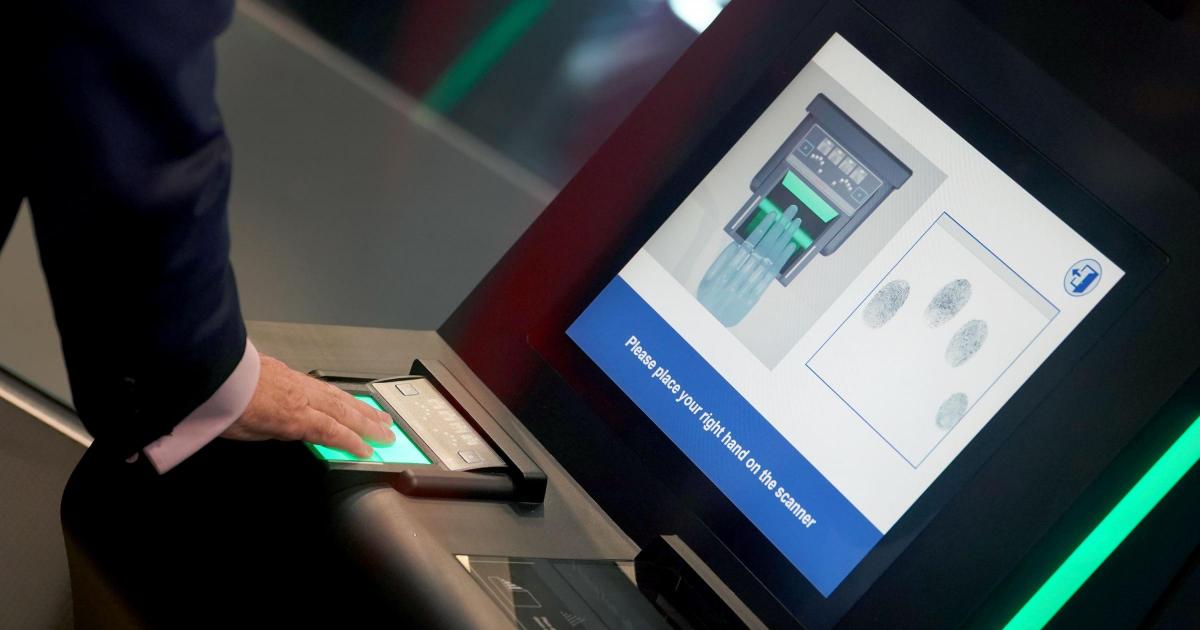The European Union (EU) is set to launch its new Entry/Exit System (EES) on October 12, changing the requirements for British citizens travelling to the Schengen area.
The new digital border system is part of wider work being done by the EU to strengthen its border security.
The Foreign, Commonwealth & Development Office explains: “EES is designed to improve border security within the EU and its neighbouring countries, and reduce illegal migration in the Schengen area.
“It will automate border control checks to help the EU stop visitors overstaying.”
The new EU Entry and Exit System explained
How will Brits be affected by the new Entry/Exit System?
British citizens (using a UK passport) travelling to a country in the Schengen area (full list below) will be required under the new EES to register biometric details, according to the Gov.uk website .
This will involve having your fingerprints and a photo taken at dedicated booths at the port or airport upon arrival.
No action is required before you travel, and there is no cost involved for the EES registration.
The Government website adds: “After it is fully implemented, EES registration will replace the current system of manually stamping passports when visitors arrive in the EU. ”
Travelling to Europe?
The new digital EU Entry/Exit System means you’ll need to register your fingerprints and photo at the border.
This may take a few minutes so be prepared to wait at busy time
For more info, check: https://t.co/l2PXM6x7ez
#EES pic.twitter.com/y6Ua1gC9wM— FCDO Travel Advice (@FCDOtravelGovUK) September 24, 2025
The new system may mean passengers are left waiting “longer than usual” at border security the first time while completing the registration.
However, once registered, your digital EES record is valid for 3 years.
If you enter the Schengen area again during this time, you will only need to provide a fingerprint or photo at the border (upon entry and exit).
Countries in the Schengen area
All countries in the Schengen area will be using the new EU Entry/Exit System. These countries are:
- Austria
- Belgium
- Bulgaria
- Croatia
- Czech Republic
- Denmark
- Estonia
- Finland
- France
- Germany
- Greece
- Hungary
- Iceland
- Italy
- Latvia
- Liechtenstein
- Lithuania
- Luxembourg
- Malta
- Netherlands
- Norway
- Poland
- Portugal
- Romania
- Slovakia
- Slovenia
- Spain
- Sweden
- Switzerland
UK passport fee guide
The Republic of Ireland and Cyprus are not within the Schengen area, so the EES will not be applicable when travelling to these two countries.
Who is exempt from using the EES?
Some Brits will be exempt from the EES, according to the EU’s official Travel Europe website . These people are:
- Nationals of the European countries using the EES (as well as Cyprus and Ireland).
- Non-EU nationals who hold a residence card and are immediately related to an EU national.
- Non-EU nationals who hold a residence card or a residence permit and are immediately related to a non-EU national who can travel throughout Europe like an EU citizen.
- Non-EU nationals travelling to Europe as part of an intra-corporate transfer or for research, studies, training, voluntary service, pupil exchange schemes, or educational projects and au-pairing.
- Holders of residence permits and long-stay visas.
- Nationals of Andorra, Monaco and San Marino, and holders of a passport issued by the Vatican City State or the Holy See.
- People exempt from border checks or who have been granted certain privileges with respect to border checks.
- People not required to cross external borders solely at border crossing points and during fixed opening hours.
- People holding a valid local border traffic permit.
- Crew members of passenger and goods trains on international connecting journeys.
- People holding a valid Facilitated Rail Transit Document or valid Facilitated Transit Document.
Diplomats travelling on a short stay may also be exempt from EES registration under certain conditions.
Members of the armed forces travelling on NATO or Partnership for Peace business may also be exempt from registering with the new EES, in certain circumstances.
Your rights if your flight is cancelled or delayed
EES to have “minimal impact”, says Eurotunnel chief executive
Eurotunnel chief executive Yann Leriche said the new EES will have “minimal impact” on customer experience, and estimated just two minutes will be added to average journey times.
Mr Leriche said: “As you will see, EES will have a minimal impact, not exactly zero, but a minimal impact on the time to cross the Channel.”
More changes coming in 2026
The EU is expected to roll out another new system in 2026, impacting Brits travelling to Europe further.
RECOMMENDED READING:
Next year will see the launch of the new European Travel Information and Authorisation System (ETIAS).
The ETIAS will mean those using a UK passport will need to apply for authorisation to enter Schengen area countries, provide personal information and details about their trip, and pay a €20 fee.
You can find out more information on the new ETIAS via the Travel Europe website (a link to which can be found above).
